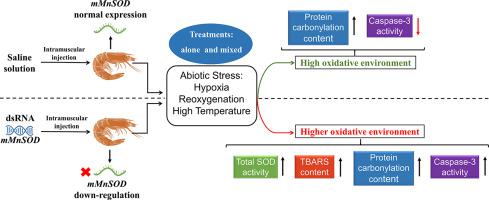Comparative Biochemistry and Physiology A: Molecular & Integrative Physiology ( IF 2.1 ) Pub Date : 2020-10-31 , DOI: 10.1016/j.cbpa.2020.110826 Ricardo González-Ruiz 1 , Alma B Peregrino-Uriarte 1 , Elisa M Valenzuela-Soto 1 , Francisco J Cinco-Moroyoqui 2 , Miguel A Martínez-Téllez 1 , Gloria Yepiz-Plascencia 1

|
Shrimp are increasingly exposed to warmer temperatures and lower oxygen concentrations in their habitat due to climate change. These conditions may lead to oxidative stress and apoptosis. We studied the effects of high temperature, hypoxia, reoxygenation, and the combination of these factors on lipid peroxidation, protein carbonylation, and caspase-3 activity in gills of white shrimp Litopenaeus vannamei. Silencing of mitochondrial manganese superoxide dismutase (mMnSOD) was used to determine the role of this enzyme in response to the abiotic stressors described above, to avoid oxidative damage and apoptosis. In addition, mMnSOD gene expression and mitochondrial SOD activity were evaluated to determine the efficiency of silencing this enzyme. The results showed that there was no effect of the abiotic stress conditions on the thiobarbituric acid reactive substances (TBARS), but protein carbonylation increased in all the oxidative stress treatments and caspase-3 activity decreased in hypoxia at 28 °C. On the other hand, mMnSOD-silenced shrimp experienced higher oxidative stress, since TBARS, carbonylated proteins and caspase-3 activity increased in some silenced treatments. Unexpectedly, mitochondrial SOD activity increased in some of the silenced treatments as well. Altogether, these results suggest that mMnSOD has a key role in shrimp for the prevention of oxidative damage development and induction of apoptosis in response to hypoxia, reoxygenation, high temperature, and their interactions, as conditions derived from climate change.
中文翻译:

线粒体锰超氧化物歧化酶敲低增加了暴露于高温,缺氧和复氧的南美白对虾对虾的氧化应激和caspase-3活性
由于气候变化,虾越来越多地暴露于温暖的温度和较低的氧气浓度。这些条件可能导致氧化应激和细胞凋亡。我们研究了高温,缺氧,复氧以及这些因素的组合对凡纳滨对虾南美白对虾脂质过氧化,蛋白质羰基化和caspase-3活性的影响。线粒体锰超氧化物歧化酶(mMnSOD)的沉默被用来确定这种酶对上述非生物应激源的反应,以避免氧化损伤和细胞凋亡。另外,mMnSOD基因表达评价线粒体SOD活性和线粒体SOD活性以确定该酶沉默的效率。结果表明,非生物胁迫条件对硫代巴比妥酸反应性物质(TBARS)没有影响,但是在28°C的低氧条件下,所有氧化应激处理中的蛋白质羰基化均增加,而caspase-3活性降低。另一方面,mMnSOD-沉默的虾承受更高的氧化应激,因为在某些沉默的处理中TBARS,羰基化蛋白和caspase-3活性增加。出乎意料的是,在某些沉默治疗中,线粒体的SOD活性也增加了。总而言之,这些结果表明,mMnSOD在虾中起着关键作用,以防止氧化损伤的发展和对缺氧,复氧,高温及其相互作用的反应诱导凋亡的发生。











































 京公网安备 11010802027423号
京公网安备 11010802027423号